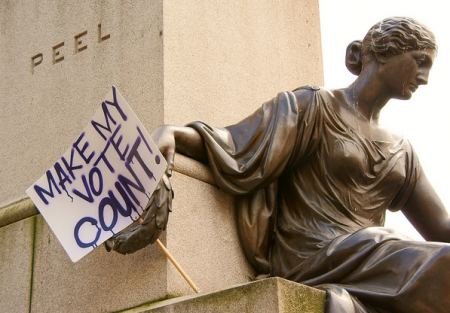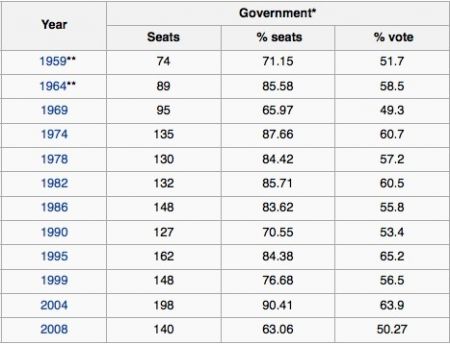Before I start, a read of Wee Wui Kiat’s excellent piece, Free & Fair Elections – The Mathematics of Representation (Stories from the East), provides a good summary of the different voting systems that can be used and how they differ. Here, I take a less polite approach against the current voting system.
When Malaysians cast their vote, they’re asked two questions. Firstly, who do you want to represent you in the State Assembly (which enacts laws that relate to agriculture, land, utilities, administration, and only relate to the state)? Secondly, who do you want to represent you in Parliament (which enacts national laws such as the penal code and taxation)? At both levels of the Malaysian Legislature, we have in place the First Past The Post (‘FPTP’) system for voting in the individual. What does not make sense is why Members of Parliament (MP) are voted in via FPTP, a system with two core elements that cripple proper representation in a national assembly.

Simple plurality and being chained to your neighbours
We understand easily enough that it may be democratically legitimate for 2 persons to outvote 1 if concessions cannot be made. After all, resources are finite and policies are severely weakened without some form of coercion. However, legitimacy becomes a very strange and plastic term when used to describe a representation of all by simple plurality. Simple plurality is not a victory by 50.1% or more but by the most number of votes. So, for example, when 3 candidates contest a seat, a candidate only needs 33.4% of the votes to win if his or her other two rivals obtain an equal number of votes (33.3%). That is a maximum possible wastage of 66.6% of votes in a 3-way fight, 49.9% in a 2-way fight, 74.9% in a 4-way fight, and so on. The higher the number of people who rise to the podium, the more the system crumbles upon itself.
Now, let’s turn to the concept of a constituency. A constituency is a line arbitrarily drawn in the sand. It’s what dictates whether you have a choice between A versus B, or C versus D. It doesn’t ask that you state whether you agree or disagree on proposed national policies, and instead, wraps a chain around an area and tells everyone within it to vote for one person to represent them all. And God help them if a 3rd idiot decides to contest and create more vote wastage. The question is why?. Why’s the voting system for Members of Parliament who decide on national laws, blind to constituency and dictated by constituency? To believe that a constituency achieves representation is to assume that political views and interests are geographically clustered. That Mr. Kamarul and Miss Ong both have the same issues in mind when they come to a decision as to how to vote, because they live down the road from one another. It’s chaining people together and nullifying their votes based on a mini majority within an arbitrary circle. It’s also pretty ridiculous.

Proportionality versus accountability
A solution is to implement a Proportional Voting System (an odd name – you’d think proportionality is a given). A commonly proposed vehicle within Proportionality is the Party List System (‘PLS’). In a PLS, a fixed number of seats for filling up is similarly prescribed, but constituencies are done away with. Instead, parties publish a list of their candidates in order of priority. Votes are cast for parties and then tallied on a national level, so almost every vote counts. Seats are then allocated to parties based on their garnered percentage of the popular vote. The parties must then (by mandate or law) distribute those seats to their candidates based on the order of priority in their list. The gist of it is that 55% of the popular vote for Party Z equals nearly 55% of seats. Nearly everyone’s vote is accounted for. Here’s a breakdown of Barisan’s electoral performance since Merdeka:

It’d seem to be a great system for true representation, but some might argue that there’s a glaring omission: the accountability of the Members of Parliament. If we were to change to a PLS from a FPTP system, the dynamics of accountability would be dramatically changed. Accountability is important because it allows us to theoretically remove an MP in the next election if he or she hasn’t been satisfactory. By placing the selection of candidates in the hands of Parties via their list, we allegedly lose that power:
Constituency: Voters -> MP
Party List: Voters -> Party -> MP
While at first glance, this argument seems to deal a death blow to Proportionality, it begs the question of how much we actually do care about who our MP is when we vote, as compared to the mandate his or her party stands for. Accountability does in fact appear; it’d still be in the very votes we cast. But our primary representative in Parliament becomes the Party, along with its mandate and track record. And to remove the idea of MP accountability is a very good thing; the value of personal attacks on an individual candidate by the opponents decreases and all sides are forced to shift their line of arguments into one of policies, not the individuals.
Imagine that.
(Featured image accompanying article on main page courtesy of Clyde Robinson, source: http://bit.ly/YjLX6m)


Australia implements the proportional system and is arguably produces the fairest outcome.
Mervyn ,
Awesome article.
Those are not the only 2 options. As long as a state has multiple constituencies, and individual candidates can be selected (as opposed to party-blocks), You can have individual-level accountability.
There is for example, the Mixed-member proportional system and Parallel voting system , which combines the 2 system in similar ways. Both systems allows you to chose your preferred candidate for your constituency, and also the most preferred party you want in parliament. Although Parallel voting is not considered to be a form of proportional representation, it has the effect of giving a better appropriation as compared to FPTP.
Another proportional representation system where individual accountability is considered is single transferable vote system., where voters vote according to preference in a multi-member constituency.
Also, what the article discuss is known as a closed party-list system. There is also an open party-list system where voters have some influence on the order in which party candidates are elected.
Agreed. The closed party list system was used as an extreme example of how greater proportional representation can be achieved. There are a ton of voting systems that have been proposed, yet we are still stuck in an archaic one.